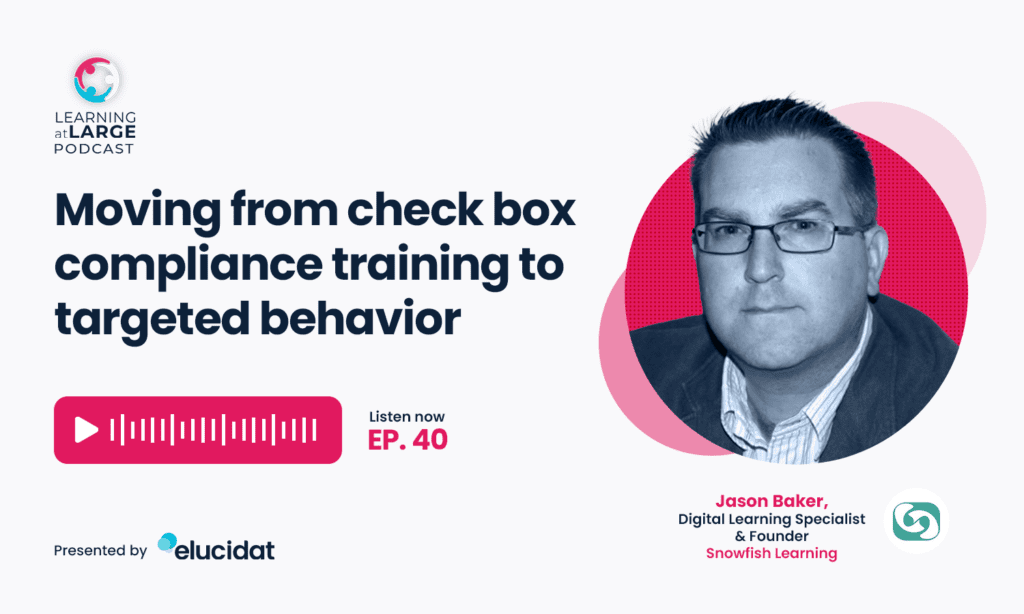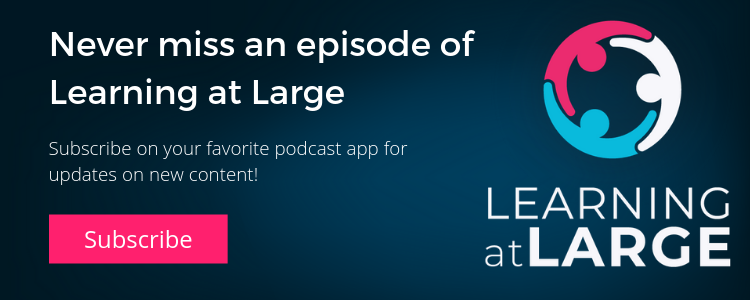Moving From Check Box Compliance: Jason Baker
Companies with compliant and ethical cultures are more successful. Yet compliance training is often seen as a burden. Something that people have to do, rather than need or want to do. Jason Baker, Founder of Snowfish Learning, wants to change this attitude. Hear how he’s refocusing compliance training on behavior. Find out how to target your business’ risks with integrated compliance training.

Top tips to create a culture of workplace compliance
Don’t have time to listen now? Here are some top tips from Jason:
- Make behavior change your goal: Compliance shouldn’t just happen to check a box. Make your goal behavior change and help people do the right thing.
- Find your ethical pressure points: Don’t take a blanket approach to compliance training. Identify your business process risks and target your learning.
- Explore the grey areas: Reflect the complex situations that employees experience. Use storytelling to explore the nuance of situations.
- Integrate compliance training: Compliance isn’t a standalone process. Include compliance training in personal development and the flow of work to meet your business goals.
1. Make behavior change your goal
Many online compliance courses are designed with the main goal of checking a box to say the business has trained its employees. But this misses the point. Corporate compliance breaches have serious consequences. And you’re not preventing a breach of laws and regulations if your training is just a legal defense when government agencies knock on your door.
In global organizations that work across regions with different rules and regulations, it can be easy to focus on teaching the law. But, for Jason, the real goal of compliance training is to change behavior and help employees do the right thing.
“The learning world spends too much of its time thinking about training content and knowledge transfer. Whereas what we’re trying to do is to deliver performance and people change…Ethics and compliance is actually all about people – people’s behavior and motivations.”
2. Find your ethical pressure points
Traditionally, compliance training courses are provided to everybody in an organization. This blanket coverage means that the few people who really need training will get it. But, for the majority of learners, it can feel like their time is being wasted. This inevitably gives compliance training a bad name.
Instead of taking a one size fits all approach, Jason suggests taking a step back and looking at the regulatory compliance issues your business faces. Recognizing your ethical pressure points helps you to target your compliance training program where it’s needed.
“Look at a business process, and say ‘We’re in this industry, and we operate in these regions of the world. We have these kinds of people involved, and these are their touch points throughout our business processes. Now where is the risk within that process?’ When you start to identify the opportunity for risk, where the decision points actually are, where there’s a right thing and a very wrong thing to be done, then you start to understand where your training need actually is.”
3. Explore the grey areas
For too long compliance training has taken a clear-cut approach. Employees have been told: ‘If you spot something that seems wrong, do nothing and tell your manager’. But this simplistic guidance rarely fits what most employees experience.
Jason recommends using storytelling to explore the nuance of situations. By looking at the grey areas, you can help employees develop the holistic skill set needed to navigate compliance risk and do their job effectively.
“If somebody’s offering you a gift, doing nothing until you can tell your manager is just simply not an option. You have to make a decision at that point. If you think there’s something a bit dodgy about it, how do you reject that gift? The skill you require is how to negotiate and maintain the business relationship you have with that person who’s offering you the gift.”
4. Integrate compliance training
In large organizations where L&D is managed and tracked on a Learning Management System (LMS), learning can be seen as a separate activity. In reality, it isn’t restricted to formal courses and certificates. People are continuously learning during their work.
Jason sees this separation as particularly pronounced in compliance training. Anti-bribery, privacy, anti money laundering…the list of one-off compliance courses could go on and on. But, just as learning isn’t a distinct activity, employees don’t experience compliance risks in isolation from their day-to-day job. So, instead of separating out compliance, integrate it with work and other types of training.
“Rather than separating business goals and compliance intention, you actually try to bring them together and say, ‘This is how we want you to go about doing the right thing while successfully delivering your business goals’. So, thinking of it as a layer, rather than something separate is the way forward.”
A quick recap
Too often seen as a check box activity, Jason has four strategies to transform compliance training.
- Instead of knowledge transfer, make behavior change your goal
- Look at your business processes and target learning to your ethical pressure points
- Use storytelling to explore the grey areas and nuance of situations
- Integrate compliance training with personal development and the flow of work to deliver business impact
Want to find out more? Check out the full podcast.
About Jason
With over 20 years’ L&D experience, Jason has worked in a variety of learning design roles with a focus on compliance and ethics. He helps organizations manage their people-risk through innovative and measurably effective training solutions.
You can find out more and get connected with Jason Baker on LinkedIn.
On Jason’s listening and reading list
Explore the books that are influencing Jason’s approach to compliance training.
Design for How People Learn (Voices That Matter), Julie Dirksen
Jason recommends this book for its learner centric approach. It covers the key learning principles that you need to create effective compliance learning.
This recent publication explores the opportunities for compliance to make the radical changes the industry needs to see.
Looking for more reading tips? Check out our books blog.
Join the conversation!
We’d love to hear your thoughts on our podcast, so feel free to get in touch with our podcast host, at kirstie.greany@elucidat.com. As always, don’t forget to subscribe to Learning at Large in your favorite podcast app and leave us a 5-star rating if you enjoyed it. Thank you for joining us, and see you next time.
